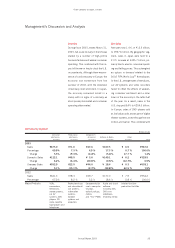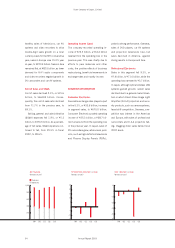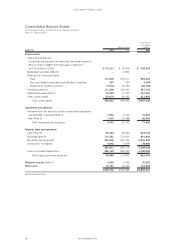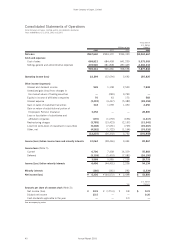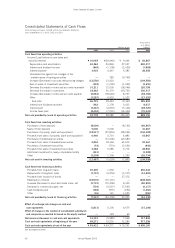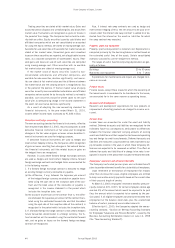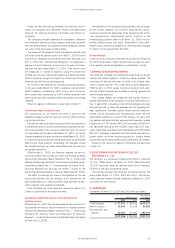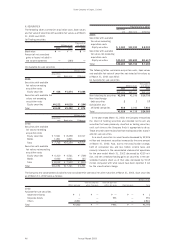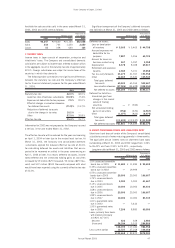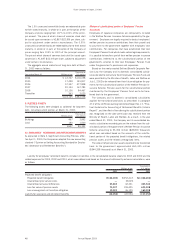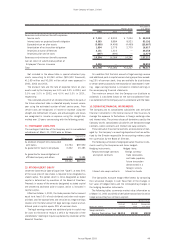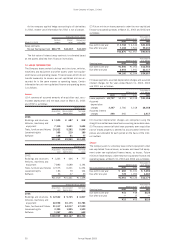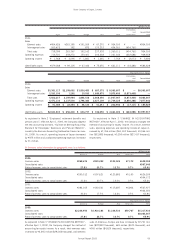JVC 2003 Annual Report Download - page 45
Download and view the complete annual report
Please find page 45 of the 2003 JVC annual report below. You can navigate through the pages in the report by either clicking on the pages listed below, or by using the keyword search tool below to find specific information within the annual report.Victor Company of Japan, Limited
Annual Report 2003 43
1. BASIS OF PRESENTING CONSOLIDATED FINANCIAL
STATEMENTS
Victor Company of Japan, Limited (the “Company”) and its con-
solidated domestic subsidiaries maintain their official account-
ing records in Japanese yen and in accordance with the provisions
set forth in the Japanese Commercial Code and accounting prin-
ciples and practices generally accepted in Japan (“Japanese
GAAP”). The accounts of overseas subsidiaries are based on
their accounting records maintained in conformity with gener-
ally accepted accounting principles and practices prevailing in
the respective countries of domicile. Certain accounting prin-
ciples and practices generally accepted in Japan are different
from International Accounting Standards and standards in other
countries in certain respects as to application and disclosure
requirements. Accordingly, the accompanying consolidated
financial statements are intended for use by those who are in-
formed about Japanese accounting principles and practices.
The accompanying consolidated financial statements have
been restructured and translated into English (with some
expanded descriptions and the inclusion of consolidated state-
ments of stockholders’ equity) from the consolidated financial
statements of the Company prepared in accordance with Japa-
nese GAAP and filed with the appropriate Local Finance Bureau
of the Ministry of Finance as required by the Securities and
Exchange Law. Some supplementary information included in the
statutory Japanese-language consolidated financial statements,
but not required for fair presentation is not presented in the
accompanying consolidated financial statements.
The translation of the Japanese yen amounts into U.S. dol-
lars are included solely for the convenience of readers, using
the prevailing exchange rate at March 31, 2003, which was
¥120 to U.S. $1.00. The convenience translations should not
be construed as representations that the Japanese yen amounts
have been, could have been, or could in the future be, con-
verted into U.S. dollars at this or any other rate of exchange.
2. SUMMARY OF SIGNIFICANT ACCOUNTING POLICIES
Principles of consolidation
The consolidated financial statements include the accounts of
the Company and its significant subsidiaries. All significant in-
tercompany transactions, account balances and unrealized profits
have been eliminated.
Investments in certain non-consolidated subsidiaries and
affiliated companies (20% to 50% owned and certain others
15% to 20% owned) are, with minor exceptions, stated at their
underlying net equity value after elimination of unrealized inter-
company profits and losses. The Company’s investments in its
remaining subsidiaries and affiliated companies are immaterial
in the aggregate, and are stated at cost or less.
The differences between acquisition cost and underlying net
equity at the time of acquisition are generally being amortized
on the straight-line method over five years.
Foreign currency translation
Current assets and liabilities denominated in foreign currencies
are translated into Japanese yen at exchange rates prevailing at
the balance sheet dates except for those hedged by foreign cur-
rency forward contracts, which are recorded at contract rates.
Prior to April 1, 2000, non-current assets and liabilities
denominated in foreign currencies were translated at historical
exchange rates.
Effective April 1, 2000, the Company and its consolidated
domestic subsidiaries (the “Companies”) adopted the revised
accounting standard for foreign currency translation, (the
“Revised Accounting Standard”). Under the Revised Account-
ing Standard, long-term receivables and payables denominated
in foreign currencies are also translated into Japanese yen at
the year-end rate.
The effect on the consolidated statement of operations of
adopting the Revised Accounting Standard was not material.
Balance sheets of consolidated overseas subsidiaries are trans-
lated into Japanese yen at the year-end rate except for stockhold-
ers’ equity accounts, which are translated at the historical rates.
Statements of operations of consolidated overseas subsidiar-
ies are translated at average rates except for transactions with
the Company, which are translated at the rates used by the
Company.
Due to the adoption of the Revised Accounting Standard, the
Company reports foreign currency translation adjustments in the
stockholders’ equity and minority interests. They were previously
included in assets or liabilities.
Cash and cash equivalents
In preparing the consolidated statements of cash flows for the
years ended March 31, 2003, 2002 and 2001, cash on hand,
readily available deposits and short-term highly liquid invest-
ments with maturities not exceeding three months at the time
of purchase are considered to be cash and cash equivalents.
Inventories
Inventories are stated at cost, which is determined primarily by
the average-cost method.
Securities
Prior to April 1, 2000, publicly-traded securities were stated at
the lower of cost or market, and the other securities were stated
at cost. Cost was determined using the moving-average method.
Securities of consolidated subsidiaries in the United States were
accounted for in accordance with the Statement of Financial
Accounting Standards No. 115 issued by the Financial Account-
ing Standards Board.
Effective April 1, 2000, the Companies adopted the new Japa-
nese accounting standard for financial instruments (“Opinion
Concerning Establishment of Accounting Standard for Finan-
cial Instruments “issued by the Business Accounting Delibera-
tion Council on January 22, 1999).
Notes to Consolidated Financial Statements
Victor Company of Japan, Limited and its consolidated subsidiaries
Years ended March 31, 2003, 2002 and 2001


